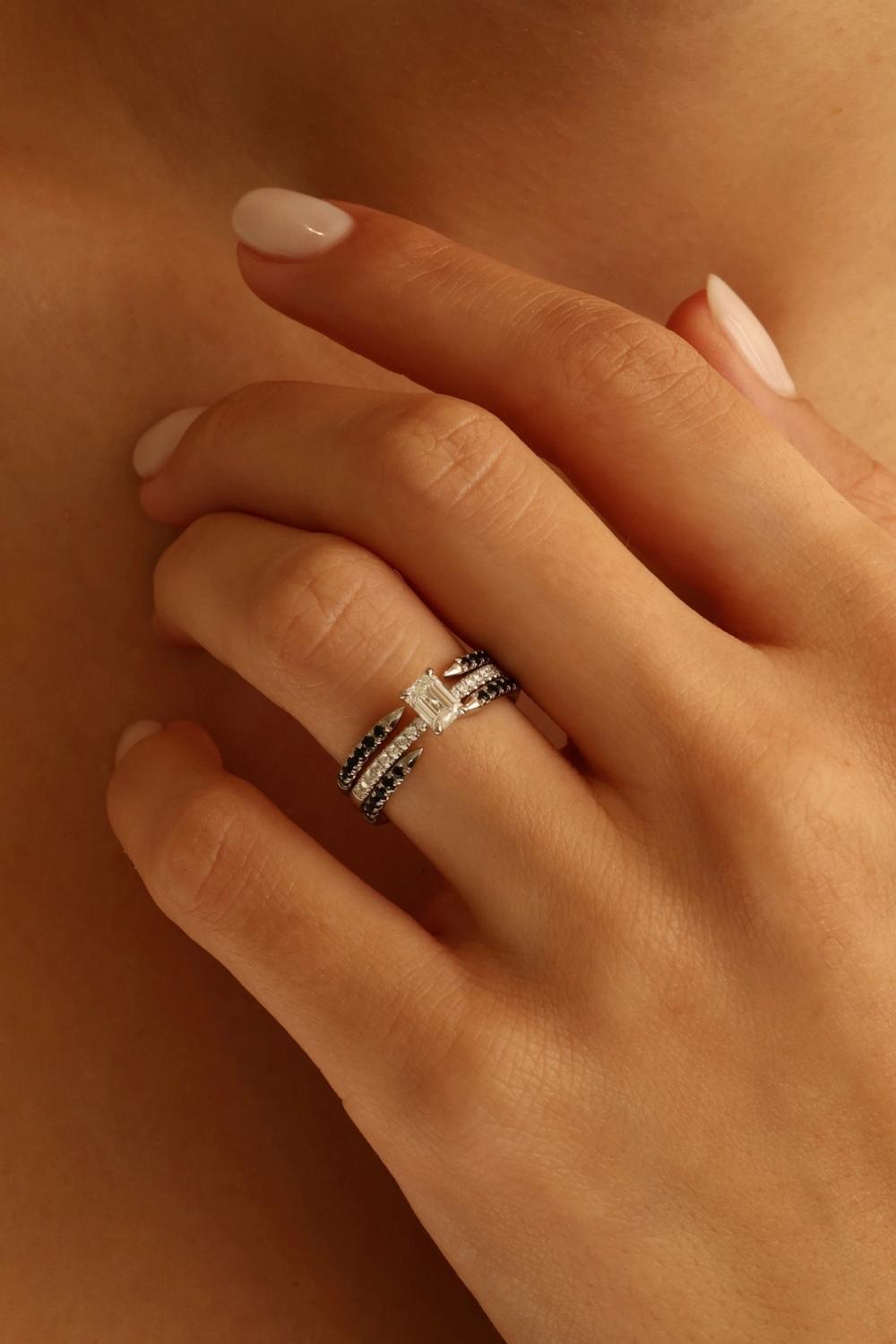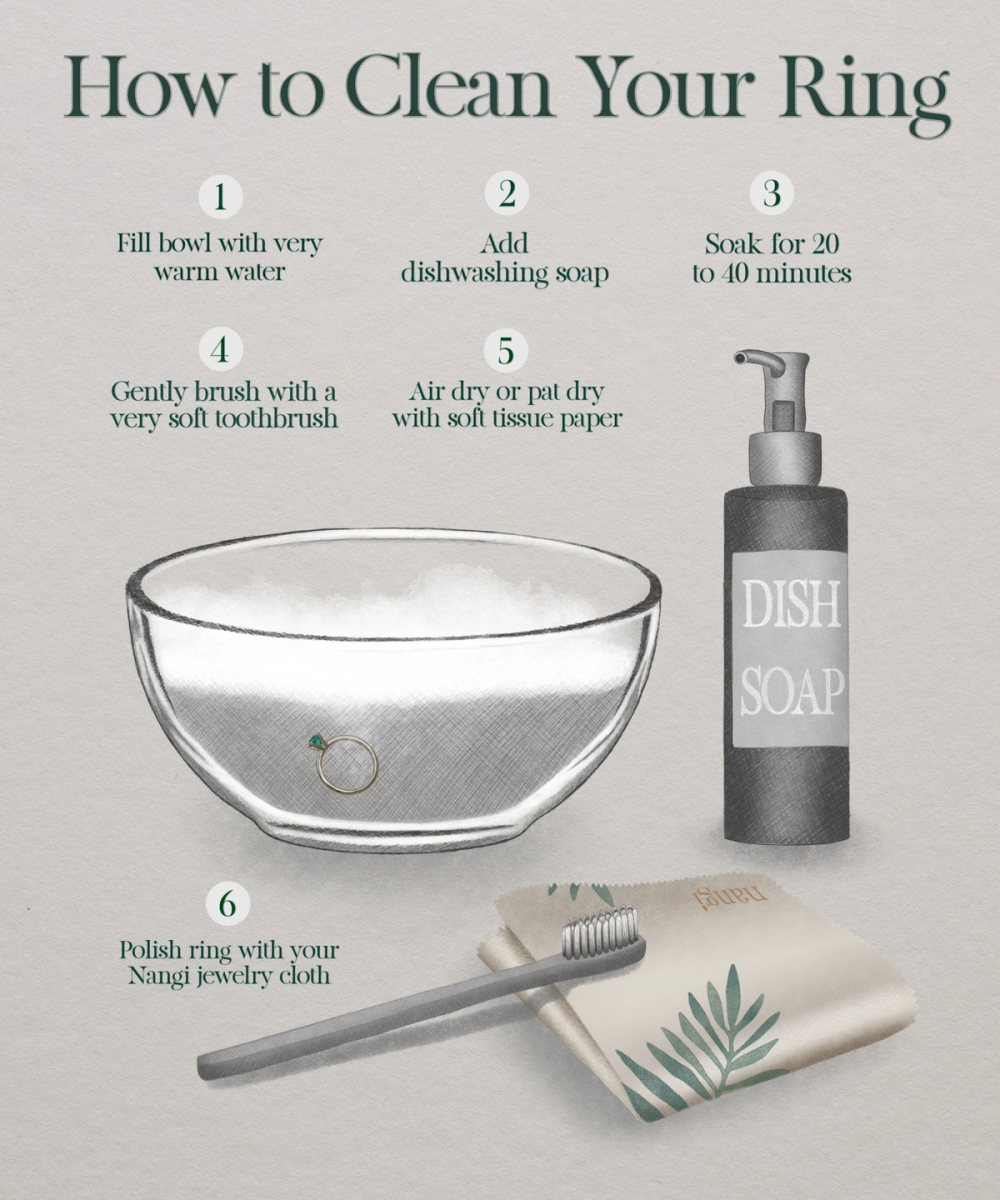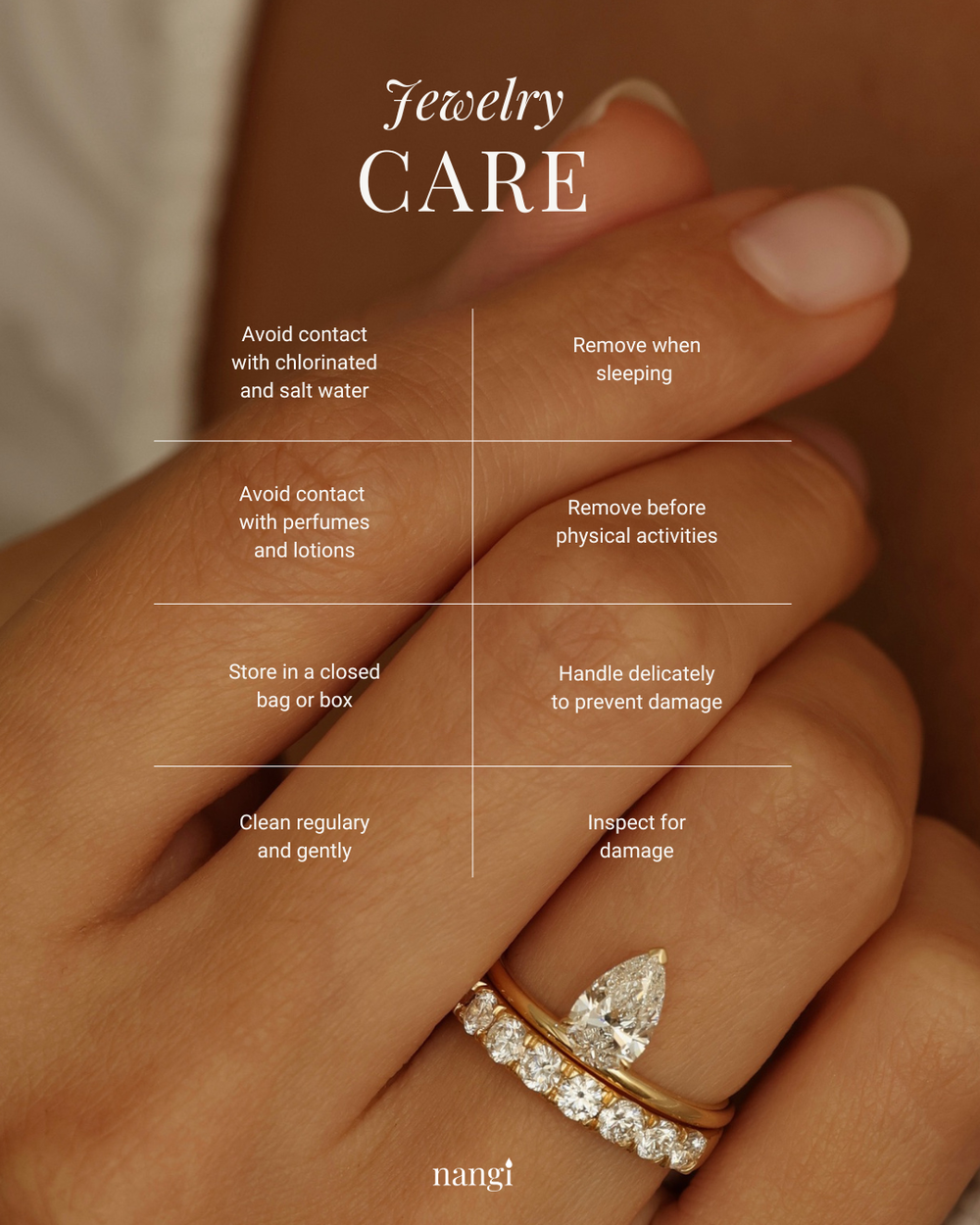Language and currency settings
Change your language and currency settings by selecting your preferences below
Select currency
Select language
Jewelry Wear & Care
At Nangi, we believe that fine jewelry is meant to be worn every day, but like all precious things, it looks its best when cared for properly. Each piece is as unique as the love story behind it, and understanding the vulnerabilities of the metals and stones in your jewelry is key to preserving its beauty.
Our skilled team is here to support you with guidance on how to protect your piece, taking into account factors like environment and wear. As a rule of thumb, we recommend taking your fine jewelry to a trusted jeweler once a year to check that all mountings and settings are secure. This simple habit will ensure your jewelry remains in excellent condition, ready to shine through every moment. At Nangi we offer a yearly service on all your Nangi rings.

HOW TO WEAR:
Showering, bathing and swimming
Prolonged submergence in water, particularly in hot temperatures, can negatively impact some stones. Pool chemicals can also degrade materials and cause further damage to gemstones.
Sleeping
It’s not recommended to sleep with any piece of jewelry that has a high profile (in the case of rings) as these can get caught and bent/ warped. Low profile rings such as simple metal wedding bands and diamond eternity bands are ok to sleep in as they aren’t at risk of catching. Chains and statement earrings are at risk of tangling, stretching and warping so we advise that you take care if you choose to sleep in your jewelry.
Applying cosmetic products, lotions, soaps or perfumes
These can degrade materials and damage the color, clarity or lustre of gemstones, either immediately or over time. Soaps and lotions also cause a build-up underneath stones that attracts dirt and can cause them to look cloudy or milky.
Exercising
Fine jewelry can be easily damaged through contact with weights or gym machinery/equipment, as well as via pressure applied during activities such as yoga and pilates. In some cases, sweat and oils from your skin can cause discoloration and skin reactions so we advise removal of pieces in advance.
Cleaning and gardening
Cleaning and household chores such as washing the dishes can expose your jewelry to soaps and chemicals (see notes above re soaps). Your jewelry can also be at risk of impact, and in the case of gardening and outdoor maintenance the piece is exposed to dirt, scratching and damaging impacts.
Doing any hands-on work, where your jewelry is exposed to chemicals
Depending on your professional life, you will need to carefully assess whether your piece should be worn during working hours. If in doubt about whether you should wear your piece in a specific situation, be safe and take it off. Adhering to these guidelines will assist in maximizing the longevity of your piece.
Engagement and long-term wear jewelry
In selecting a fine piece of jewelry for your engagement or wedding ring, you must be aware of the additional care and maintenance guidelines to ensure the longevity of your piece. Pieces are only guaranteed in the case where jewelry has been cared for in line with the provided care instructions. Fine pieces require additional care over the course of time. If you have any questions or concerns about your piece throughout its lifetime, please contact us and we will assist you in any way possible.
STORE & CLEAN
Cleaning
Polish your jewelry with the provided polishing cloth. Jewelry with stones (excluding stones that require special care) can be cleaned with warm soapy water and a soft toothbrush. Cleaning is also a great time to inspect your piece and check if the stones are secure. We offer complimentary polishing and cleaning of your Nangi jewelry every 12 months. This is recommended, especially for white gold pieces, which require rhodium replating every 12-18 months to maintain their bright, silver-like shine. Please note that rhodium replating is not included in our yearly service and will incur an additional cost. Avoid using ultrasonic cleaners for pavé set jewelry, delicate stones, or stones that need special care.
Storing
When not being worn you should store your jewelry carefully. If possible, store each piece of jewelry in a way that it is not in direct contact with other materials or jewelry to avoid scratching. The Nangi Walnut Box is perfect for storing. Ensure that all chains are individually stored to avoid tangling and knotting, and that stone pieces aren’t subject to being knocked or rubbing on other pieces.
Insurance
Insurance is vital for precious pieces, especially where the value exceeds $5000. Ensure you are covered for loss, accidental damage or theft. We recommend keeping an up-to-date inventory of your jewelry collection including images and valuations, in the unfortunate case that something does go missing.

STONES
When to check your stones
Pieces with stones require extra care, specifically those with precious stones. We recommend having stones checked every 4-6 months (based on regular wear), to ensure they are not loose. You can check this at home by gently tapping the surface of the stone with your fingertip and watching for any movement or listening for any clicking. If you have knocked your piece, or if you suspect a stone is loose, refrain from wearing it until it can be checked professionally.
Special care stones
Special care stones include, but are not limited to, opals, moonstones, pearls and emeralds. These stones are soft, fragile or specially treated, and therefore require special care and careful wear.
Diamonds
Diamond is the hardest natural material on earth, however, these stones still require a certain level of care in order to ensure their longevity. Chipping, cracking, scratching and cleaving are all still possible if diamonds come under extreme force or sudden intense impact. Diamond pieces need meticulous care, and regular checking. Wear according to the above care instructions is imperative. Loose diamonds can damage the metal in settings, so we recommend professional checking of diamond solitaires every 12 months for tightness, which is a service we provide free of charge.
Pavé settings
Fine, pave set bands should be worn with care at all times, to avoid loosening stones. Check your ring regularly for any signs of loose stones and if you have knocked your piece, or if you suspect a stone is loose, refrain from wearing it until it can be checked professionally.
BY PRODUCT TYPE
Necklaces and bracelets
When unworn, take care not to tangle fine chains. If a clasp appears as though it is becoming loose, do not wear the necklace or bracelet, but return it to us for checking. Avoid wearing fine chain pieces around pets or small children who might pull on or catch the chains as they can be stretched or snap and cause potential injury. Store fine chains individually to avoid tangling and knotting.
Earrings
Avoid wearing earrings in any scenario where they could catch or be pulled, such as during impact sports or high intensity activities. If you feel your earring backs are loose, avoid wearing them and contact us for replacements.

ANNUAL SERVICE AT NANGI
We are delighted to offer you a complimentary annual maintenance service for your jewelry, ensuring that your treasured pieces remain as radiant as the day you received them.
Once a year, you are entitled to
- Professional cleaning and polishing to restore your jewelry’s shine
- Inspection of prongs and overall condition to ensure durability and security
Please note that rhodium plating for white gold is not included in the complimentary service. However, we are happy to assist you with this at an additional cost.
If any further repairs or modifications are needed beyond standard cleaning and polishing (e.g., loose diamonds or loose prongs), we will contact you before proceeding with any additional work.
How to use this service
To take advantage of your annual maintenance service, simply bring your jewelry to our studio in Oslo, Norway.
If you live outside of Oslo and are unable to visit our studio in person, you can still benefit from this service. However, please note that you will be responsible for all shipping costs, but we are more than happy to assist you with the shipping process for both sending your jewelry to us and having it returned.
Let us help you keep your Nangi jewelry in perfect condition for years to come!
Join the Nangi family!
Subscribe to our newsletter to be the first to know when we release new one-of-a-kind pieces, and gain exclusive access to secret sales and events
Norsk side
Nangi Fine Jewelry © 2024